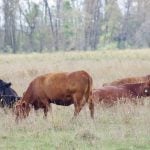Inoculating pulse crops with peat or liquid formulations can be a hassle. It has to be done in the field, with the seed used as soon as possible after application to give the bacteria the best chance to survive and work their magic.
Granular formulations have made the job easier, but they’re more expensive and are not immune to equipment failure. However, because proper inoculation is such an important part of producing a profitable pulse crop, Darren Watson has used peat and granular inoculant at the same time.
Read Also

VIDEO: Green Lightning and Nytro Ag win sustainability innovation award
Nytro Ag Corp and Green Lightning recieved an innovation award at Ag in Motion 2025 for the Green Lightning Nitrogen Machine, which converts atmospheric nitrogen into a plant-usable form.
“If you ever have a mechanical problem, like a bridge in your tank, there’s no fertilizer, and that’s bad, especially if you’re on land that has never had lentils on it before,” said Watson, who grows lentils and other pulse crops near Avonlea, Sask.
“Our old seeder was a little bit less reliable. You get the odd bridge or an electric clutch that doesn’t quite work right. So what we did was buy the cheapest peat we could find, for like a buck a bushel. Granular inoculant costs seven bucks an acre. Say you’re seeding a Milestone lentil at a bushel an acre. You can put on $1 an acre with the peat, then rather than seven put on $6 an acre with granular, so 86 percent of the full rate.”
This system provided Watson with inoculant on the seed and the added insurance of granular inoculant in the seed row. When he filled the seed compartment in his air cart, he’d apply the full rate of peat on the seed with a Nuttall inoculant applicator. The granular inoculant would go in the third tank of his cart.
“The idea is you can withstand a failure in one of your systems with no extra cost. I know it’s a pain, but I have sprayed $5,000 worth of nitrogen on a field, and had the crop not do as good because of an inoculant failure,” he said.
“Anyone that’s dealt with granular inoculant, if you’ve never had a failure, you’re doing good. It can trick you, if you’ve got a partial blockage. You can seed all year with a partial blockage and you’ve got eight-foot strips everywhere. So it’s a bit of a pain, but for the money it costs you, it’s cheap insurance.”
Watson said he knows the setup has saved him twice: once with a bridge in the tank and once when a clutch on the air cart wasn’t working right.
“We actually did have a granular failure the first year we did it. I’ve also had to go and reinoculate fields. We used to have a disc drill, so I went and reseeded with a tenth rate of seed and the inoculant. I did that all night one night,” he said.
“You can either redo it, rely on old bacteria or add nitrogen. I sprayed nitrogen on chickpeas one year. I think I put on 60 pounds (per acre) when they were just coming out of the ground. And that is expensive.”
Although he admits there’s “absolutely no science to it,” Watson’s theory is the system provides different modes of action on the colonization of roots.
“A granular inoculant colonizes the soil. If you look at the root of a granular inoculated plant, there’s lumps of nodules spread out. When you put it on the seed, there’s globs of nodules just right by the seed and fewer out on the roots.”
Although he admitted it’s just a theory, he said it would be a positive offshoot of the cheap insurance.
“But the main one is you’re not spending any more money and it doesn’t take any extra time because you just put the Nuttall inoculator (on when filling the cart). It’s not going to kill you if you run out with 10 bu. left, because there’s some redundancy built in.”
He thinks the system would also work if it started to rain while applying peat.
“They say the bugs are only good for 48 hours. So you get a rain. Are you going to take (inoculated seed) out of the seeder and reinoculate it? You get the benefits of both.”
Watson said many combinations of granular, liquid and peat inoculant could be used to provide this type of insurance.
“If you had a third tank, but you didn’t want to use granular inoculant because you thought it was too expensive, you could go with a quarter rate of granular as a shield for uneven peat applications when you use peat as the main source of inoculant.”
Watson said he’s not doing it this year, only because he’s using a new air cart, which he’s counting on to be reliable.
“It’s not that we don’t think it’s an excellent idea. It’s that with the new cart, we think we can get away with it.”
Near Rouleau, Sask., Curt Dobson has used liquid and granular inoculant for two years.
His initial concern was seed damage when augering from the truck to the air cart in the field.
“We’re using a regular auger that comes with our Flexi-Coil air cart, with the steel flighting. We thought we’d use water or something liquid to take the chatter out of the grain going up the tube. I thought I might as well be putting inoculant onto it rather than water,” said Dobson.
He uses half the recommended rate of liquid inoculant and about three lb. of Bionode clay granular inoculant.
Dobson used his system on yellow peas and three kinds of lentils, but used water only on chickpeas.
He puts granular inoculant in the small compartment in the air cart and seed in the back compartment and sidebands liquid phosphorus.
“I’ve seen in the past when we’re using straight granular, it seems like we have a stage in the growing season earlier in June when the lentils turn a mint green, like a lighter colour. It seems like they may be starving for nutrient a little bit.
“It took a little while for the roots to get to the granular inoculant, so we were thinking the liquid might close that gap a bit. But in the end, as far as yield was concerned, I don’t think we gained a heck of a lot.”
Dobson said even with half rate liquid and half rate granular, he was still using one of the more expensive inoculating programs. This year he’s using all granular because of last year’s poor harvest and the resulting cash flow problems.
“If we think we missed it this year, we’ll go back to it in ’06. We did it for two years and liked what we saw, but didn’t necessarily think we were getting any better return for ourselves. What we may try is an in-field trial and put a little on to see if it works.”
He said he might also try shutting off the liquid phosphorus and using TagTeam granular.
“My thoughts are, if I can see no real advantage or disadvantage, I’d stick with the TagTeam and I wouldn’t have to pull my liquid wagon around and deal with liquid fertilizer during the pulse season.”














